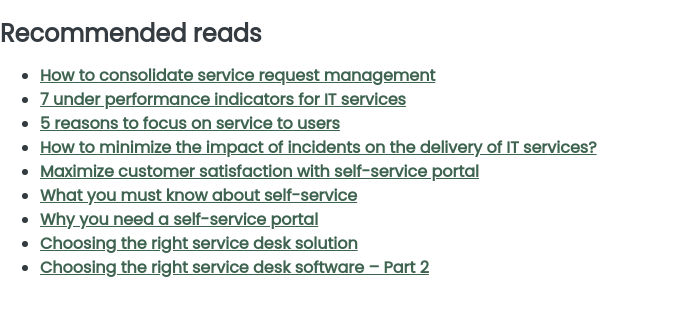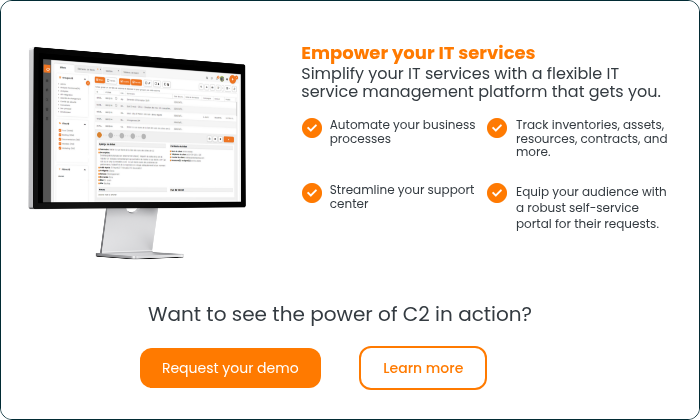ITSM’s role in business efficiency and success
Better service delivery
ITSM bases like ITIL (Information Technology Infrastructure Library) provide systematic approaches to delivering services, reducing downtime, and improving service availability. This enables businesses to operate smoothly, minimizing disruptions and downtime that impact productivity.
Incident management
With ITSM, organizations can establish efficient incident management processes to respond quickly to IT issues. Faster resolutions lead to reduced service outages, less downtime, and increased employee productivity.
Problem management
ITSM emphasizes identifying the root causes of recurring incidents and addressing them proactively. By preventing issues from reoccurring, ITSM helps avoid repeated disruptions, ultimately leading to better business efficiency.
Change management
ITSM's change management practices ensure that modifications to IT services are carefully planned, tested, and controlled. This minimizes the risk of introducing errors or disruptions, maintaining business continuity and efficiency.
Streamlined operations
ITSM helps standardize and automate processes, reducing manual efforts and errors. This streamlined approach results in more efficient workflows and optimized resource utilization.
Enhanced customer satisfaction
Efficient IT services lead to better customer experiences, both internal (employees) and external (customers). When IT services meet user expectations and provide timely support, customer satisfaction improves, positively impacting the business's reputation and success.
Data-driven decision-making
ITSM frameworks often emphasize data collection and analysis, enabling businesses to make informed decisions based on real-time performance data. This data-driven approach can lead to more effective resource allocation and service improvements.
Business alignment
ITSM structures focus on aligning IT services with business needs and objectives. This alignment ensures that IT resources are used effectively to support business goals, contributing to overall business success.
Now that we’ve established some fundamental features of ITSM and its role in business success, we can better understand the industry's current developments.
How can automation revolutionize ITSM processes?
Artificial Intelligence and automation will continue to play a significant role in ITSM, helping organizations improve efficiency, reduce costs, and enhance the customer experience. AI-powered chatbots, for example, will become more sophisticated and can handle a broader range of customer inquiries, freeing up IT support staff to focus on more complex issues.
Automation is critical in transforming ITSM by streamlining repetitive tasks, reducing human error, and improving overall efficiency. For example, incident management response time is significantly reduced, leading to better service request fulfillment, which in turn helps improve reporting and analytics and increases scalability and, ultimately, a transformative effect on business with a boost in productivity, further enhancing workflows.
It's important to note that while automation can bring significant benefits, it should be implemented thoughtfully and strategically. Identifying the right processes for automation and ensuring proper testing and monitoring are essential for successful automation in ITSM.
Increased focus on customer experience
ITSM plays a crucial role in enhancing customer experience by streamlining and optimizing the delivery of IT services. It ensures that the organization's IT processes are aligned with customers' needs and expectations, leading to improved customer satisfaction. As competition increases, organizations must emphasize delivering a positive customer experience. Additionally, ITSM enables better communication and collaboration between IT teams and customers, facilitating a deeper understanding of customer requirements, feedback, and pain points.
By employing best practices and incorporating customer-centricity into ITSM strategies, organizations can actively focus on understanding and meeting customer needs, preferences, and priorities. This can be done by analyzing customer feedback, integrating customer preferences into service design, and regularly assessing customer satisfaction in areas such as incident management, problem resolution, and service request fulfillment. This increases the reliability and availability of IT services, directly impacting the overall customer experience. All of this lends to ITSM evolving in a way that aligns more closely with customer expectations.
This trend helps drive the development of a more personalized, proactive, and efficient approach to reducing wait times and improving overall satisfaction. Self-service portals, mobile apps, and chatbots will become increasingly important in providing customers with quick and convenient access to the information and support they need. Adopting a customer-centric approach empowers ITSM to continuously improve services, anticipate customer needs, and tailor IT solutions to deliver exceptional experiences, ultimately fostering stronger customer relationships and loyalty.
Software integration and optimization
ITSM, DevOps, and Agile are three interconnected approaches to improving an organization's software development, delivery, and operational processes. Embracing a collaborative approach between these practices is essential for achieving synergy and better outcomes.
When these methodologies work together, they complement each other’s strengths and create a more holistic and efficient approach to software development and service management. The organization benefits from increased agility, improved customer satisfaction, and a culture of continuous improvement.
How does ITSM help businesses adapt to remote work and the modern workplace?
First and foremost, ITSM frameworks, such as ITIL, provide structured methodologies to manage IT services effectively. With remote work, employees are often scattered across different locations, making it challenging for IT teams to provide support and maintain a consistent level of service. ITSM helps establish standardized processes, workflows, and service catalogues that ensure remote employees receive timely and consistent IT support, regardless of physical location.
The migration of IT services to the cloud will continue to accelerate, mainly driven by its many benefits, such as scalability, cost savings, and increased agility. Robust communication and collaboration tools are vital for remote teams, as they integrate collaboration platforms and communication channels. ITSM ensures seamless interaction between remote employees and IT support staff. This facilitates efficient information sharing, real-time issue resolution, and effective remote team collaboration.
The modern workplace heavily relies on various digital technologies and cloud-based solutions. ITSM helps businesses efficiently manage these technologies by providing comprehensive asset controls and tracking capabilities. IT teams can monitor and support remote employees' devices, software, and applications through ITSM platforms, ensuring they are up-to-date, secure, and compliant with company policies. Additionally, ITSM platforms often offer self-service portals where remote workers can access knowledge bases, FAQs, and troubleshooting guides, empowering them to resolve common IT issues independently without waiting for IT support.
ITSM is a crucial enabler for businesses embracing remote work and the modern workplace. It empowers remote employees to remain productive by providing efficient IT support and ensuring smooth operations of digital technologies and applications, ultimately contributing to the success and adaptability of remote work arrangements in today's dynamic business landscape.
What are the latest ITSM trends in security and compliance?
The IT landscape constantly evolves, so it is essential to keep current on recent changes. Of course, cybersecurity will continue to remain a top priority for organizations as cyber threats evolve and become more sophisticated. This trend will drive the development of new technologies and processes to prevent and mitigate cyberattacks, such as threat intelligence, security automation, identity and access management, and machine learning.
Organizations must adopt a more proactive approach to cybersecurity, compliance, and privacy regulations. It is vital to keep up with data protection laws and incorporate them into their overall ITSM strategies to ensure the security of their IT services and data. Organizations must consistently safeguard customer data and adhere to data protection requirements.
Remember that the specific security and compliance measures for ITSM will depend on the organization's size, industry, and regulatory environment. Staying informed about the latest cybersecurity developments and industry regulations is crucial to maintaining an effective security posture within ITSM environments.
In conclusion, ITSM stands at the forefront of revolutionizing business efficiency. By embracing the latest trends and adopting best practices, organizations can position themselves for sustainable growth and success in an increasingly competitive landscape. As technology evolves, staying informed about the latest ITSM advancements will be the key to unlocking new possibilities and maintaining a competitive advantage.
A great ITSM platform can ensure you're ready to step into the future and run as smoothly and efficiently as possible. C2 ITSM helps businesses manage workflows, enhance IT capabilities, and foster productivity.











